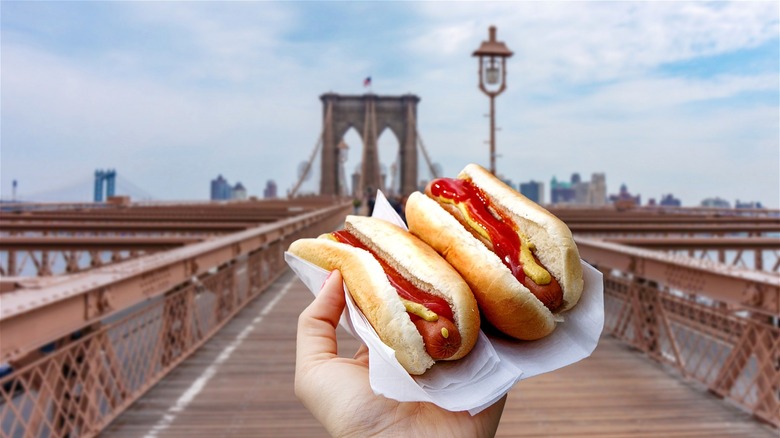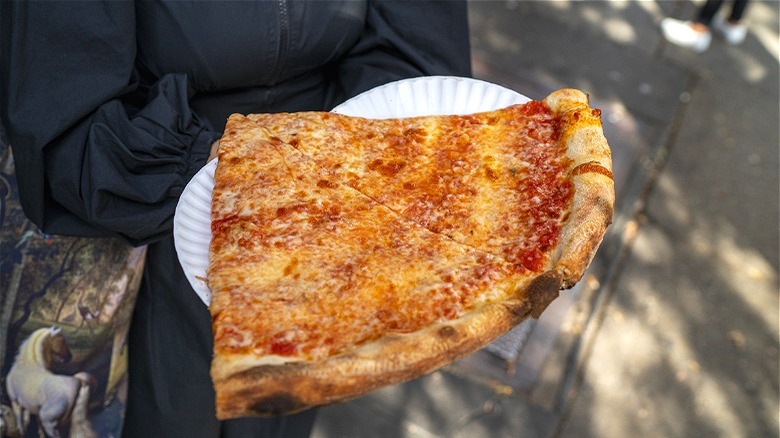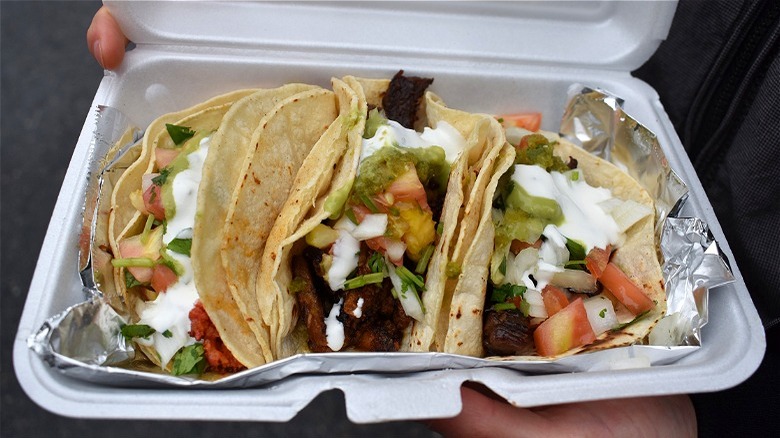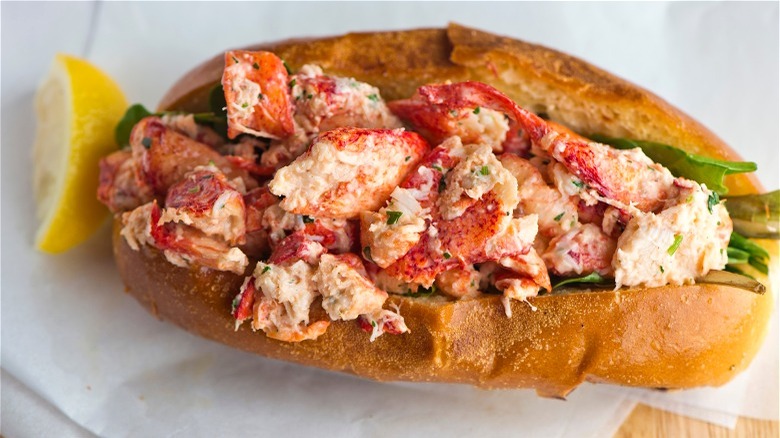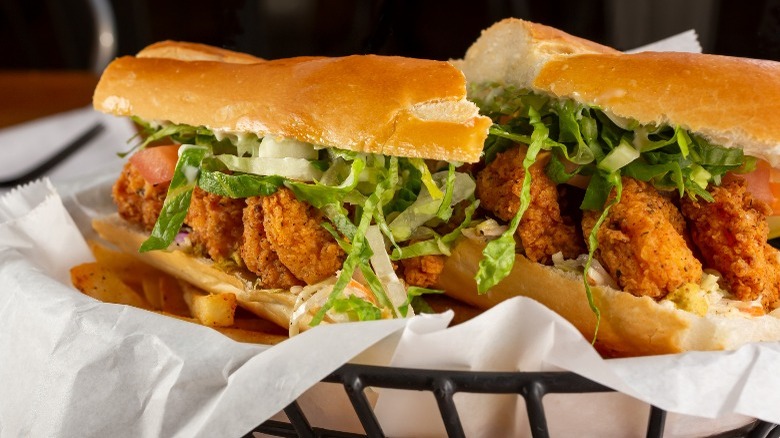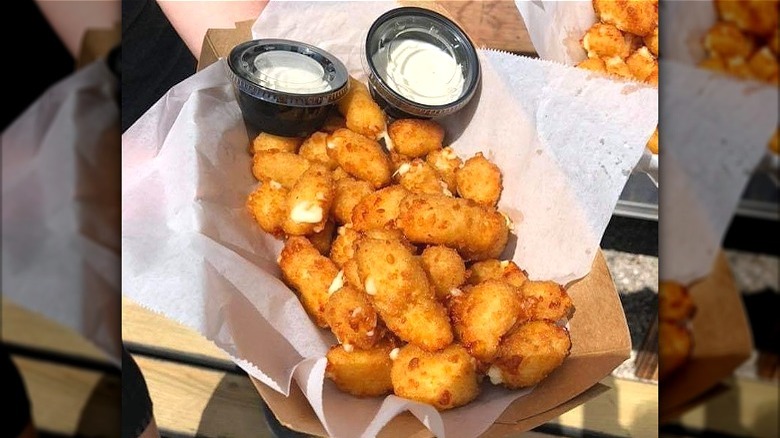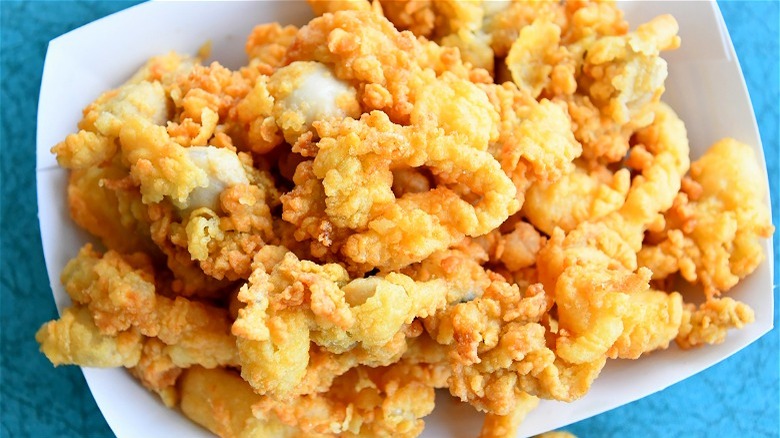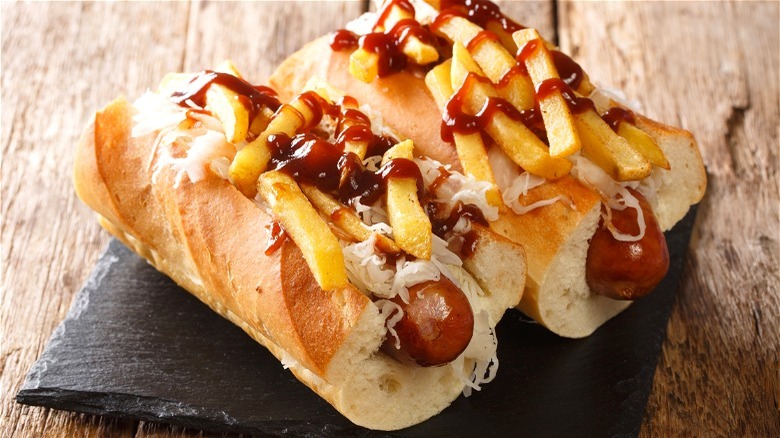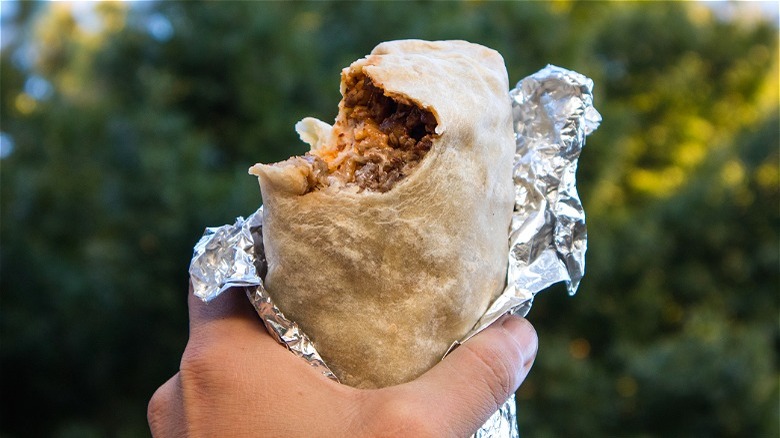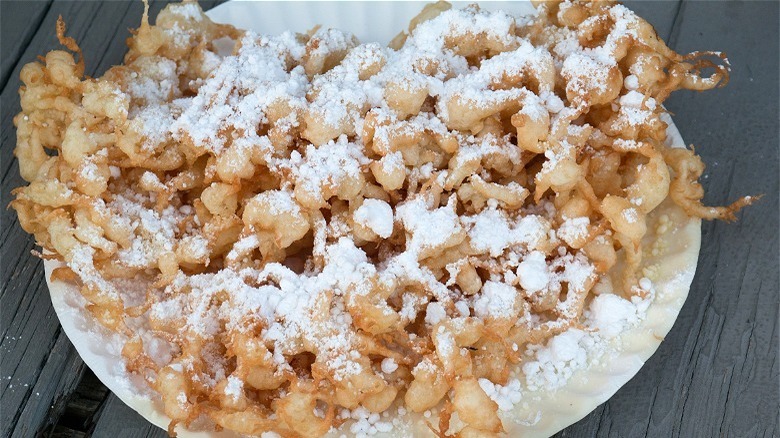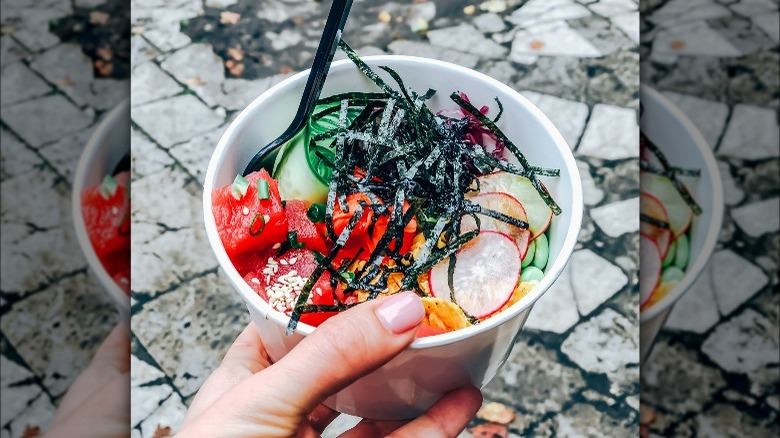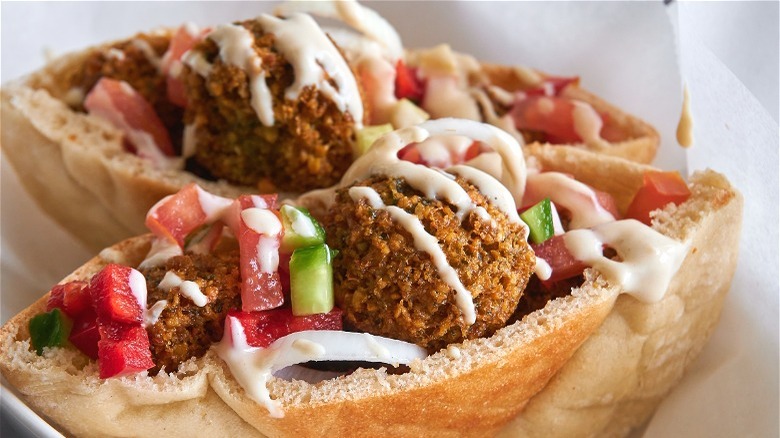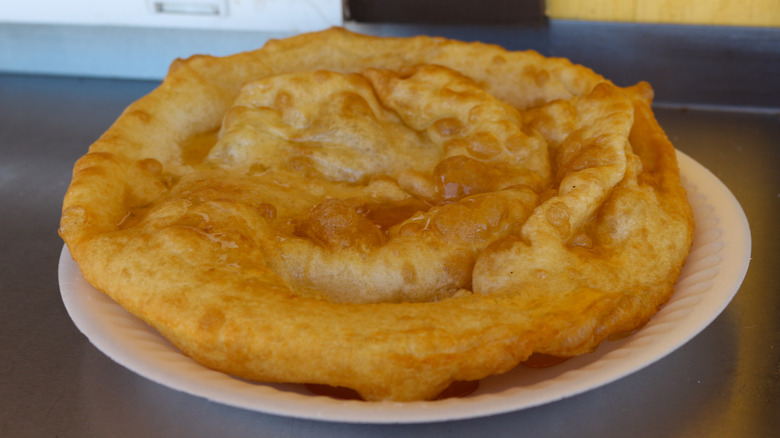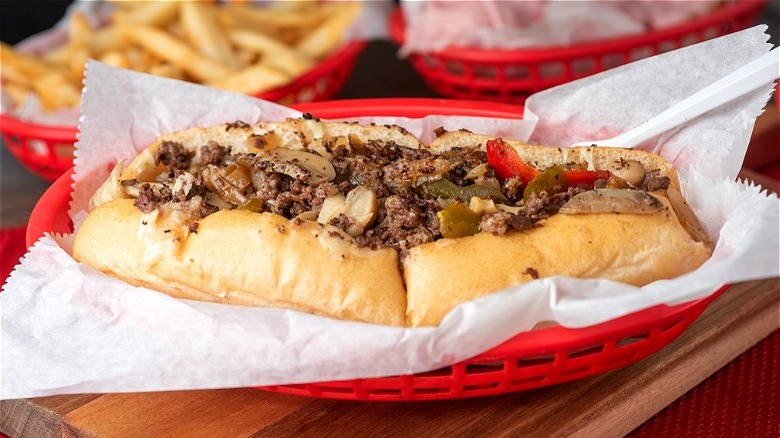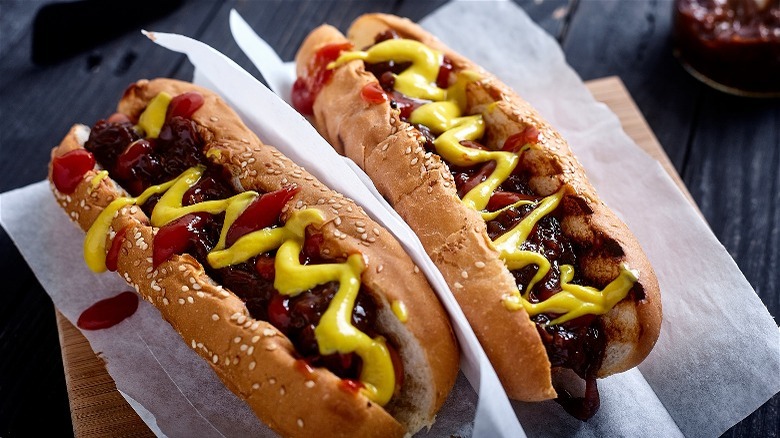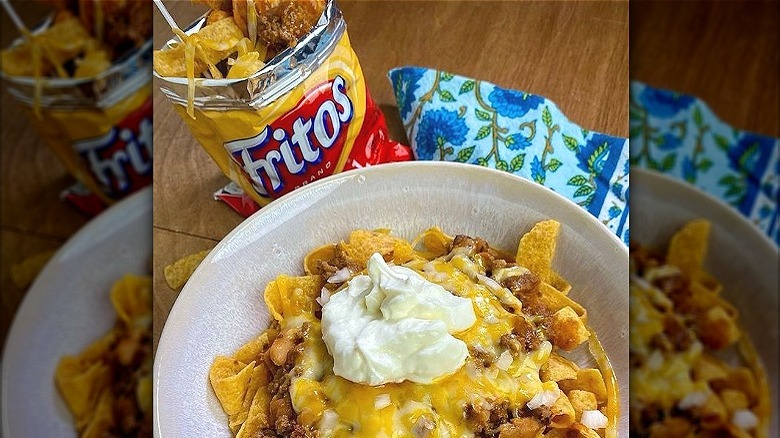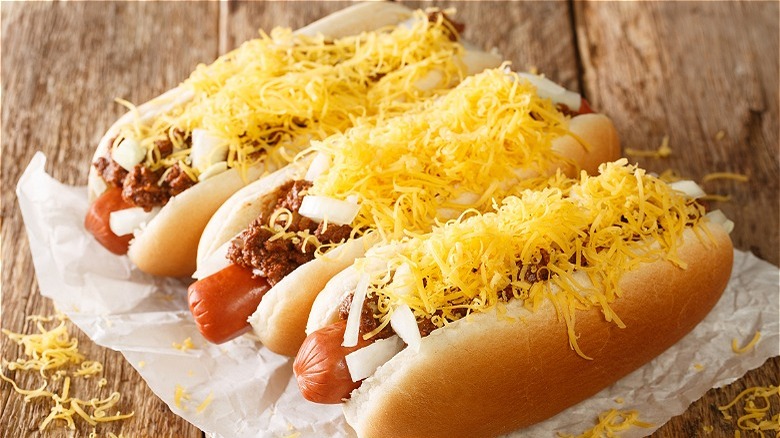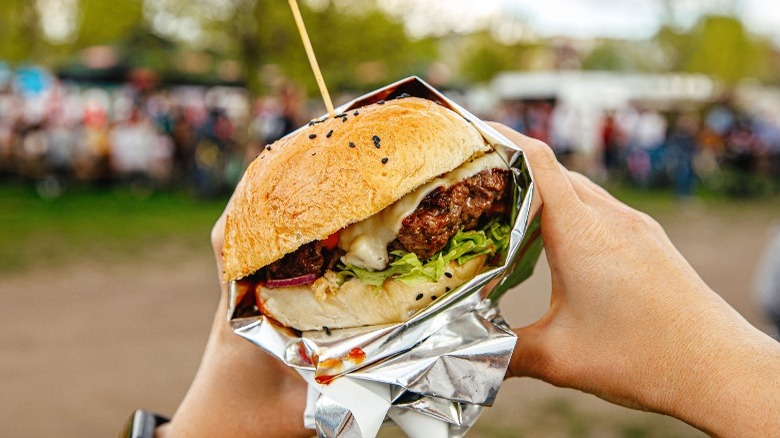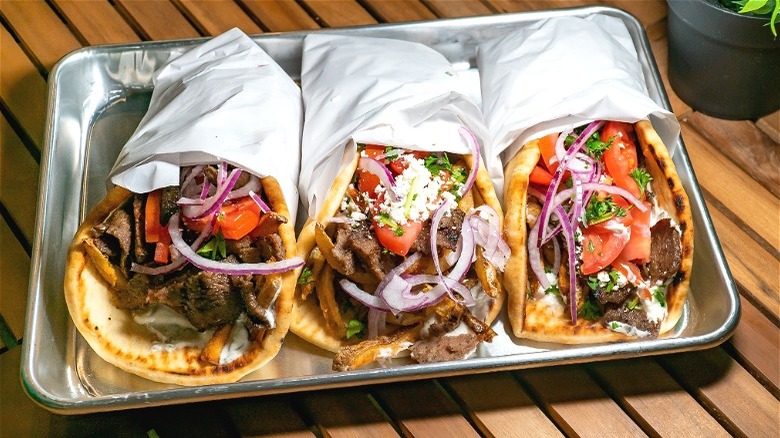The Absolute Best Street Foods In The U.S.
Great street food is defined by a few key attributes. Street food should be portable, utensil-free, and handheld. Standing or walking can take place at the same time as eating such foods. The dish is usually prepared in a food truck, push cart, or on the side of the road. Most of the time, these meals should be filling and comforting, while having a low price point. All of these traits are not strictly required, but a lot of the best street foods in the U.S. tend to have these things in common. Additionally, many of them contain strong connections to American history that infuse these quick bites with welcome nostalgia.
There are plenty of popular and beloved street foods to highlight. In addition to those mentioned in this list, recognizable dessert street foods like donuts, churros, and ice cream, come to mind. But for this roundup, we focused on savory items. Read to learn about the absolute best street foods in the U.S.
Soft pretzel
The pretzel came to the U.S. during the 1700s when German immigrants brought the recipe from Europe to Pennsylvania (via History). By the 1800s, the first commercial pretzel bakery opened in the state. Over time, the hard pretzel gained more popularity, but the soft pretzel stayed a Pennsylvania tradition. Local pretzel factories expanded, eventually employing more workers in Philadelphia (via New York Times). In Philly today, some of the best places to get soft pretzels are the Center City Soft Pretzel Company, Miller's Twist, and the Philly Pretzel Factory, explains Visit Philly.
Usually, American pretzels are savory snacks, with flakes of salt topping each twisty treat. This kind normally comes with dips, such as mustard or cheese sauce. But you'll also come across soft pretzels as dessert, topped with cinnamon and served with icing. Soft pretzels can even come in different shapes. The Philly ones are shaped like figure eights, but others resemble more of a heart shape (via BillyPenn).
As street food, you'll generally find soft pretzels displayed inside a food truck or food cart case. They're already baked (and maybe not the freshest) but they ordinarily taste good enough. Soft pretzels make great street food, as they're easily consumable, portable, and digestible. This is something you can grab (for a low cost, as with most great street food dishes) and eat while walking in a short amount of time. It's not an American invention, but the soft pretzel is a great U.S. street food.
New York pizza slice
New York's Italian food scene itself has been around for generations — think back to John Travolta's famous pizza-ordering scene from the 1977 film "Saturday Night Fever" — but the dollar slice is a more recent phenomenon. Per Vice, it didn't become popular until 2008, around the time of the national financial crisis. At that time, New York's street food scene exploded, providing cheaper food options to struggling residents. Sadly, it's also now mostly a thing of the past, with inflation increasing the cost of NYC slices, explains The New York Times. You're more likely to pay over a dollar these days.
These to-go slices remain authentic street food items. You can eat them on the street while walking. Consuming these slices quickly is so common that there is even a recommended way to do so: by folding. If you fold the slice in half down the middle, you can eat it twice as fast.
The efficiency of New York pizza shop workers, the water quality increasing dough's flavor, and the thin style that's indicative of NYC pizza all contribute to this street food's success. It's cheap, easy to eat, and comforting — all qualities of the best American street foods.
Taco
The United States was first exposed to tacos around 1905 when Mexican migrants brought the recipe into the country (via Twisted Taco). Los Angeles and San Antonio are considered the first two taco-serving cities, per Smithsonian Magazine. Tacos were first thought of as street food. They were affordable, primarily sold from carts or other outdoor vendors, and filling. Today, tacos are no longer limited to this dining category, but they still make great food on the go.
Tacos in the U.S. can vary endlessly in their different preparations. American-style tacos are usually prepared with shredded cheese, flour tortillas, or ground beef. With more authentic Mexican tacos, you'll get a simple combination of one protein (such as fish or meat), one or two toppings (like salsa, herbs, or something else vegetal), and a corn tortilla. Different types of tacos are associated with one type of meat (such as beef, pork, chicken, fish, or goat) and how that meat is cooked. Al pastor, carne asada, barbacoa, carnitas, birria, and tinga are familiar styles of taco sold in the states.
As street food, tacos are helpfully portable and handheld. Each tortilla holds everything in your meal and no utensils are necessary. But even so, the meal is bound to be somewhat messy. Soft corn tortillas can become soggy and break, spilling their contents. Hard shell tacos can become a crumbly mess after one bite. We recommend you don't walk while eating your taco. But you can eat a taco standing up.
Corn dog
The origin story of corn dogs is contentious. As one story goes, two vaudeville performers brought corn dogs into the world at the 1942 Texas State Fair (via Bar-S). At the time, the dish was referred to as "corny dogs." Another tale credits the Oregon-based chain Pronto Pup with selling the first dogs. Other early corn dog sightings were reported in Oklahoma and Illinois. Even as early as 1927, an inventor from New York was patenting devices similar to those used to make corn dogs.
Corn dogs aren't the same type of food as tacos — which we might associate with late nights possibly involving alcohol — but both dishes are street food. These hot dogs on sticks don't require utensils and can be eaten while walking. We wouldn't say every corn dog is made fresh on the street. But you can sell corn dogs out of a restaurant on wheels (such as a food truck or cart). Corn dogs also remain a staple of certain outdoor venues, such as theme parks, beach boardwalks, and county fairs.
Per The Village Voice, corn dogs get their name from their batter, which is made with cornmeal. To make them, hot dogs are partially skewered, coated in batter, then deep-fried. Today, you might come across the Korean corn dog, street food that's been popular in recent years. These items add a layer of melted cheese or additional toppings to the cornmeal batter.
Lobster roll
The lobster roll is found all over New England. Vermont, Maine, Massachusetts, New Hampshire, Connecticut, and Rhode Island all sling these seafood sandwiches (via Lobster Anywhere). Many cite the Milford, Connecticut restaurant Perry's as the home of the very first lobster roll, per Culture Trip. But people credit Maine with making the food famous. Around the 1970s, lobster rolls began to pop up at several roadside stands in the state.
Depending on what state you're in, a lobster roll will be prepared differently. Maine lobster rolls are served cold, while Connecticut lobster rolls are typically hot, per The Manual. New England-style hot dog buns or brioche rolls can be used as the bread for either. The sandwich also involves simple ingredients like butter, mayonnaise, salt, and pepper for added flavor (via Lobster Anywhere).
If you're going to eat street food, you're going to eat it outside. If you're going to eat outside, why not have food that compliments the space? Lobster rolls do just that. There's nothing like enjoying these fresh, buttery seafood bites while looking over the New England shoreline. In this way, lobster rolls help food tourists further immerse themselves in the local culture.
Po' boy
A po' boy is a New Orleans favorite. Out of the many famous dishes invented in this Southern metropolis, the po' boy is one of the most well-known. According to Nola.com, the local sandwich first appeared during the 1920s. A restaurant created the sandwich as an inexpensive way to feed struggling workers. It consisted simply of leftover roast beef bits, gravy, and French bread. When the workers would show up to get their sandwiches, the restaurant would announce the arrival of another "poor boy." The name later became synonymous with the sandwich, with the accent's local touch changing it to "po' boy" instead.
You'll find more than roast beef in a po' boy today. Per the French quarter's tourism website, fried seafood po' boys are the most popular. Other sandwich ingredients like tomatoes, lettuce, and pickles, are added. As for dressings, you'll find mayonnaise, gravy, or remoulade (a rich sauce that originated in France) enhance the filling quality of a po' boy.
As street food, po' boys are satisfying. There's so much stuffed into this sandwich — from the thick baguette to the fish-filled center to the toppings to the sauces — that's hard to not be full after eating one. Also, they are usually cheap. A po' boy can fill a diner's belly without breaking the bank. That's something we like about this street food.
Fried cheese curds
Fried cheese curds weren't invented by Midwesterners — they've been around since ancient times. But now, they're mostly associated with the state of Wisconsin, which produces more cheese than any other state. Wisconsin is responsible for making more than one-quarter of American cheese. To handle this level of production, the state is home to a large number of cows, dairy farms, and cheese plants. Thanks to the state's thriving cheese industry, there are plenty of snacks to be made with local goods, such as fried cheese curds.
Cheese curds themselves consist of young, fresh cheese. They can be produced as a byproduct of the cheddar cheese-making process, per Golden Age Cheese. Instead of letting the cheese fully age, curds are harvested earlier on. If the curd is truly fresh, when you bite into one, it will produce a loud squeak. To turn them into Wisconsin's favorite fried snack, you dip each curd into the batter, then deep-fry them.
As Thrillist explains, fried cheese curds are more than just filling. They are quintessential comfort food. What could be more indulgent than deep-fried cheese? Each bite is a self-contained dish, balancing the saltiness of the batter with the delicately cheesy flavor of the curds. If you are lucky enough to come across this street food, you likely won't be disappointed.
Fried clams
Fried clams are a delicacy you'll find at seafood shacks across New England. But most locals agree the first clams were served at Woodman's. The Essex, Massachusetts eatery initially created the dish in 1916. This landmark restaurant is still open today. Over 100 years later, they are still serving fried clams.
As the New England Historical Society explains, there is a debate among fried clam enthusiasts: bellies versus strips. Clam bellies are the central, main portion of meat inside a clam (via Bentley's Roast Beef). Strips are cut pieces of Atlantic surf clams, which are usually larger than the shellfish used for their bellies (via Pangea Shellfish). Ipswich clams are what provide those bellies (via Historic Ipswich). According to a poll from New England Today, it seems that most people in the region prefer bellies. However, if you're outside of those six Northeastern states, you're probably going to get clam strips.
Strips vs. bellies aside, fried clams are a revered form of street food. Each piece of clam balances fish flavor with fried batter. When served with a creamy, acidic sauce like tartar sauce, the whole dish is even more well-rounded. This is a historic piece of American finger food that you can eat on the street. However, it would be best on a street that's near the ocean. The atmosphere will perfectly complement your catch of the day.
Polish Boy
The Polish Boy is a lesser-known piece of American street food culture. That is, of course, unless you're from Cleveland, Ohio. This Midwestern city's iconic sandwich was likely invented in the 1940s by Virgil Whitmore, owner of Whitmore's Bar-B-Q, per Scene. According to one tale, Whitmore combined one smoked beef sausage (somewhere between a Polish kielbasa and a hot dog) with toppings of french fries, barbecue sauce, and coleslaw.
You can eat a Polish Boy today at several eateries in Cleveland. As This is Cleveland explains, most of those restaurants are barbecue places. There's Banter, Hot Sauce Williams, Mabel's BBQ, and more. Yes, these are actual restaurants, not food trucks or food carts. However, meals don't necessarily have to be served on the street to be street food.
These Cleveland-style hot dogs aren't the type of thing you can eat while walking without making a mess. But the fact that they are upgraded hot dogs gives them street food points. Hot dogs are American street food's bread and butter. Even better, the Polish Boy comes with french fries already applied. This is an essential quality of street food: an all-encompassing bite. You don't need to sit down to a spread — all of the items are combined into one sandwich.
Burrito
Burritos were initially invented somewhere in Mexico, but historians don't know exactly when or where (via Vox). The dish came to the United States at some point during the 1900s. Around the 1940s and 1950s, the recipe began to gain more American fans, starting with Californians. Some people credit the Los Angeles restaurant El Cholo with first introducing the burrito to the U.S., says The Plaza Restaurant.
A crucial development — in terms of this fare as street food — came with the invention of the mission-style burrito. In 1960s San Francisco, a restaurant called El Faro was the first to supersize this street food. Instead of just a few ingredients, burritos were now stuffed with everything you'd want in a meal inside of two huge tortillas (via Refinery 29). Then, the whole thing was wrapped in foil. This conveniently held everything together, while allowing diners to take them to-go. Today, there are even more unique styles of this street food. You'll find breakfast burritos, chimichangas (fried burritos), wet burritos (covered with sauce and cheese), and more. But the best styles are those ready for eating while strolling on the street.
Funnel cake
Dishes similar to funnel cake existed long before this fried treat came to the United States (via Britannica). Like pretzels, funnel cake was brought to Pennsylvania by a group of German immigrants. This group is known today as the Pennsylvania Dutch, but they spoke German (via Reading Eagle). As early as the 17th and 18th centuries, the Pennsylvania Dutch were making fried dough desserts for themselves, per Greatist. But funnel cake took off during the 1960s at the Kutztown Folk Festival. These annual celebrations honored the culture of the Pennsylvania Dutch. Before long, funnel cake became a staple of other fairs and outdoor celebrations throughout the U.S.
This deep-fried dough dessert is usually made outside, making it a common type of street food. But you can make funnel cake at home. Simply get a pot of hot oil, some dough, and powdered sugar. To make it, small pieces of dough are submerged in frying oil. Once inflated from cooking, they are removed from the heat and topped with confectioner's sugar.
Funnel cake was invented to be eaten outside. We'll find ourselves digging into a plate of it in the great outdoors at theme parks like Knott's Berry Farm or county fairs, both of which celebrate Americana. Along with being nostalgic, funnel cake, as a fried, indulgent, and comforting dish, is surely one of the best street foods in the U.S.
Poke
In some ways, poke doesn't seem like typical street food. It's considered healthy, isn't deep-fried, and doesn't contain (land-based) meat. But for all the ways that this street food isn't typical of American fast food, poke bowls are emblematic of Hawaiian food culture. In Hawaii, dishes involving poke have existed since ancient times. This rich history aligns it with old European-inspired street foods that are now popular in the U.S. (such as funnel cake or pretzels).
As Foodicles explains, native Hawaiians would make their version of the poke bowl long before colonizers arrived on the islands. Dishes involved raw fish, seaweed, and salt. Later on, Japanese and Chinese travelers brought ingredients like soy sauce and sesame oil — which would one day be used to make poke bowls — to Hawaii. In the '70s, the term poke became used to describe the way fish was cut into small pieces. But it wasn't until around 2012 when the poke bowl itself became popular in the rest of the United States, per Eat Poke Bros.
Unlike many street foods, to eat poke, you do need utensils. But at least you don't have to worry about making too much of a mess. The ingredients within poke — things like rice, cucumber, and green onions — aren't the most dangerous to the street food eaters' fits.
Falafel
Falafel is not from New York City by any means (it is a thousand-year-old dish likely from Egypt) but it's a central part of the street food culture in the Big Apple. One of the oldest examples of this is Mamoun's Falafel, a Greenwich Village eatery founded by a Syrian immigrant in the 1970s (via Forbes). Then there's Moshe's Falafel, a long-time food truck that started serving falafel dishes in the 1980s.
As The Manual explains, falafel got an extra boost during the food truck craze of the late 2000s and early 2010s. This may have helped the Halal Guys, a food truck that had been operating since the 1990s, to finally open a brick-and-mortar shop. But regardless of this movement, there are plenty of other places to get falafel in NYC, especially from the hundreds of halal carts spread throughout the city.
One of the most popular ways to serve falafel is in a sandwich. Falafel itself is made of a deep-fried mixture of ground chickpeas with herbs, spices, and other ingredients. Usually, this is served on pita bread, which has been opened into a hollow shell. Then, tahini or other sauce is added. You'll also find additional toppings like tomato, lettuce, cucumbers, and pickles on the sandwich. A sandwich is the best way to enjoy falafel as street food. Everything is combined into one portable container, there is a fried component, and it's usually affordable.
Fry bread
As Visit Arizona explains, fry bread's origins can be traced back 150 years to the forced migration of Native American people from Arizona to New Mexico. During this period, the Navajo were made to walk 300 miles by the U.S. government. Rations provided to sustain the Navajo during the journey included salt, flour, lard, and water. These ingredients became the basic recipe for fry bread. Fry bread is a symbol of the unfairness of this walk, as well as the resilience of the Native Americans who went through it.
Fry bread is traditionally served at outdoor celebrations honoring Native American culture, per Mental Floss. Stands selling fry bread will make the dough fresh outside, forming it into small circles similar to a fluffy pancake or puffed-up tortilla. Then, toppings like powdered sugar or honey are applied. In other situations, fry bread is used to make recipes like Native American Tacos, also known as Navajo Tacos. These recipes consist of ingredients like beans, cheese, sour cream, and salsa being stacked onto a piece of bread (via Smithsonian Magazine).
Fry uniquely celebrates an element of Native American food history (albeit one created out of injustice from the U.S.-government). It's also delicious and portable, so it's the perfect street food.
Cheesesteak
Cheesesteaks have been a part of the food culture of Philadelphia, Pennsylvania for nearly 100 years. It was in 1930 that Pat Olivieri, founder of Pat's King of Steaks, came up with the cheesesteak (via Visit Philly). The then-food cart owner tried something new: He put onions and some steak on the grill, then put it all on a bun. Cheese would come later. But that didn't matter, it was already a hit.
Since then, several classic cheesesteak restaurants have popped up in Philadelphia. In the City of Brotherly Love, there's the famous rivalry between Geno's and Pat's. But there are also dozens of other spots to get a cheesesteak. Some of the most notable are Tony Luke's, Jim's, and John's Roast Pork. But you can pretty much find cheesesteaks anywhere in America these days. You don't necessarily have to be in Philadelphia, although some may say you're sacrificing authenticity when you stray too far from the Pennsylvania metropolis.
These meat sandwiches began as street food and will remain so. You may have to walk into a building to get one. You may want a few napkins around when you dig in. But the cheesesteak is still great street food that's perfect for a quick lunch or a late-night meal. It's indulgent, with meat and melted cheese at the core of it all. But those ingredients are also what make it simple and comforting.
Hot dog
According to Forbes, the recipe for this simple sausage was born out of German food culture in Chicago, where immigrants often ate sausages. In the 1860s, the city's hot dog-making factories flourished. In 1893, the Columbian Exposition took place in Chicago. Hot dogs were such a hit at the fair that they began to be served in other public spaces (like ballparks). The addition of the hot dog bun is attributed to St. Louis, and New York is credited with coming up with the name. Some people also credit New York with inventing it, since food carts allegedly sold hot dogs as early as the 1860s.
While the development of the mainstream hot dog was a collaboration between different U.S. cities, regions differ in specific hot dog recipes. Depending on where you're getting this street food from, toppings and other ingredients will vary. According to the National Hot Dog and Sausage Council, New York's come with yellow mustard and steamed onions. Chicago-style hot dogs utilize relish, onions, peppers, pickles, tomatoes, mustard, and celery salt. Other prominent styles include the Sonoran dog, the Fenway Frank, and more. Don't get us started on the chili dogs — those are a different story.
Frankfurters are unquestionably street food. They're portable, filling, comforting, and can be eaten while standing (and for some, while walking). They also carry with them a bit of nostalgia, like the other greatest street foods in the U.S.
Frito pie
Frito pie is a regional street food that some U.S. residents may go their whole lives without encountering. But those from Texas and New Mexico may be very familiar. Frito pie is simply cheese, chili, and onions put inside a bag of Frito chips. Jalapeños, cilantro, and sour cream are sometimes added. According to The Local Palate, Americans from the Southwestern U.S. have been eating Frito pie since the 1930s (according to the Texas origin story), or possibly the 1960s (according to the New Mexico version of the tale).
This dish is most often served at Texas school lunches or football games (via Houstonia Magazine). This gives it that outdoor quality of street food. It can also easily be prepared outside since all you need are the supplies to make chili. The dish comes in a bag, so you easily eat it while walking or standing. To some, the concept doesn't sound amazing. But to others, the Frito pie's association with childhood events like school lunch, along with it being a regionally-beloved recipe, make it nostalgic comfort food. To those people, Frito Pie is one of the best street foods in the U.S.
Chili dog
Michigan is probably the birthplace of the chili dog. As early as 1910, a Greek immigrant named Constantine "Gust" Keros was selling hot dogs alongside chili from a food cart in Detroit (via Vox). Just a few years later, in 1914, a restaurant called Todoroff's — located in Jackson, Michigan — started serving chili-topped hot dogs. Despite Coney Island itself being located in Brooklyn, New York, the term "Coney Island chili sauce" was used to describe the products sold by Todoroff's in Michigan. "Coney Island" would even become the name for a chain of Michigan restaurants serving chili dogs (via Smithsonian Magazine).
The recipe for chili dogs, explains The Atlantic, is a combination of different food cultures. Mexican immigrants brought the chili element. Greek, Macedonian, and other Balkan cultures influenced the meat-filled sauce (which is loaded with traditional seasonings like oregano). German and Eastern European cultures had already popularized the element of sausage or hot dog meat. Over time, other toppings like cheese, ketchup, and bacon were added, per The Culture Trip.
Confusing origin story aside, the chili dog is synonymous with street food. Just try to imagine eating one of these indoors. You can't. You shouldn't bring a chili dog inside, it's too messy. But that's what makes it great for consuming outdoors.
Burger and fries
The term "hamburger" comes from Hamburg, Germany, where beef patties were sold starting in the 1800s (via Tori Avey). The birthplace of the American beef-on-bun version is claimed by many states. Different stories connect the burger's beginnings to Connecticut, Wisconsin, New York, Ohio, or Texas (via History). Most of these origin stories date the burger's creation to the 1800s or early 1900s. In the 1890s, mentions of the hamburger began to pop up frequently. According to the Washington Post, newspapers in Illinois, Nebraska, California, Nevada, Hawaii, New York, Iowa, and Virginia all reported something on hamburgers pre-1900s.
Due to these many conflicting and sometimes overlapping stories of the first hamburger, we don't have the time to go into detail on each one. Just know that over time, for as many contrasting tales of the burger's inception that cropped up, regional recipes for burger preparation did, as well. There's the steamed cheeseburger from Connecticut (via First We Feast). Per Koa, you might also come across the New Mexico green chile burger, the Wisconsin butter burger, the Minnesota Juicy Lucy, or the Oklahoma onion burger in your travels.
All of this is not to mention the vast history of burgers as fast food. But the burger's ability to be eaten in the car, or on the go, had an impact on fast food culture (and much more). This very quality also makes burgers great street food.
Döner/shawarma/gyro
Döner, shawarma, and gyros are three different, yet related foods. Döner kebab is a dish that comes from Turkey (but is now popular in Germany, per Thrillist), gyros are Greek, and shawarma is a meal prominent throughout the Middle East, explains Spinning Grillers. What these three have in common is their cooking method: on a vertical, turning rotisserie. In addition, all three have a prominent place in American food culture, typically as street food.
In the states, you'll often come across döner, shawarma, and gyros as sandwiches served with various flatbreads. Inside the bread, along with meat, there will be different toppings. On a gyro, you'll find things like red onion, tomato, tzatziki, and fries. On shawarma, toppings are often ingredients like hummus, fattoush, tabouleh, and tahini sauce. Lettuce, tomato, pickles, and other similar components are used on döner kebabs (via MasterClass).
In American cities where you're lucky enough to come across these meat sandwiches, they make great street food. Meat, vegetables, and other toppings are encompassed in portable pockets of bread. It's like getting a hamburger, but instead of being made from one patty, you're getting several thin slices of meat. Since that meat has spent hours marinating and being cooked on a rotisserie, the effort in creating such a sandwich goes above and beyond.
